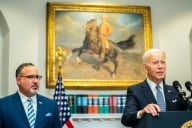You have /5 articles left.
Sign up for a free account or log in.
As brutal a year as 2007 was for the student loan providers who gathered under a cloud in suburban Washington Thursday, it has been very, very good for the for-profit college and investment types who met elsewhere in the nation's capital, at the Career College Association's first Higher Education Investment Conference.
"We thought about piping in 'Happy Days are Here Again' " as theme music, Jerry Herman, an analyst at Stifel Nicolaus & Co., quipped at the start of a presentation on the state of the market for the major publicly traded higher education companies. "It has been a pretty spectacular year."
After three years of flat or even declining stock prices, the 10 providers that Stifel Nicolaus's analysis tracked have seen their average stock price rise by 57 percent so far in 2007, elevated by significantly larger gains for some players, like Capella University's 180 percent increase.
That turnaround occurred even as enrollment growth slowed, in an industry that Herman's colleague, Robert Craig, characterized as "maturing" rather than accelerating wildly as it did a few years ago.
Over all, the analysts painted a decidedly upbeat picture for the for-profit college sector, noting the expectation of continued growth in the pool of college goers into the early part of the next decade, the greater availability of federal financial aid (via increased Pell Grants and expanded loan limits) on which so many of the colleges' students depend, and the resolution of a significant number of the regulatory and legal hurdles that some of the leading college companies have faced in recent years.
"The legal and regulatory situation has improved drastically," Craig said.
The sector is not without its challenges, though, financial and otherwise. Herman noted that the credit crunch stemming from the controversy over subprime mortgages could limit the ability of small and midsized higher education companies (typically those that aren't publicly traded) to raise money for expansion from private equity and other sources.
Craig pointed out that for-profit college providers face "a pretty significant number" of lawsuits under the False Claims Act that accuse them of defrauding the federal government through questionable admissions or financial aid practices.
Another potential regulatory hurdle went unmentioned in Thursday morning's presentation, but was foremost on the minds of some attendees at the meeting as they chatted in the hallways. A legislative change pending in Congress could significantly raise the cohort default rate for student loans for many colleges, and given that many for-profit colleges have many low-income borrowers and default rates that are already high compared to most other sectors of higher education, such a change could endanger access to federal financial aid for many institutions in the sector.









